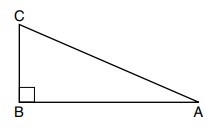This exam was adminstered in January 2023.
More Regents problems.
January 2023 Geometry Regents
Part I
Each correct answer will receive 2 credits. No partial credit.
1. In the diagram below, a line reflection followed by a rotation maps
△ABC onto △DEF.
Which statement is always true?
(1) BC ≅ EF
(2) AC ≅ DE
(3) ∠A ≅ ∠F
(4) ∠B ≅ ∠D
Answer: (1) BC ≅ EF
A rotation preserves size and shape, so the two triangles are congruent and their corresponding parts are congruent. So the answer is the choice that lists two corresponding parts.
In Choice (1), BC correspondes to EF, so this is the correct answer.
In Choice (2), AC corresponds to DF, no DE. Eliminate (2).
In Choice (3), ∠A corresponds to ∠D, not F. Eliminate (3).
In Choice (4), ∠B corresponds to ∠E, not D. Eliminate (4).
2. A circle is continuously rotated about its diameter. Which threedimensional object will be formed?
(1) cone
(2) prism
(3) sphere
(4) cylinder
Answer:(3) sphere
If spun around its diameter, a sphere would be formed in three dimensions.
The other choices are not possible, regardless of the axis of rotation.
3. In the diagram below of △CER, LA || CR.
If CL = 3.5, LE = 7.5, and EA = 9.5, what is the length of AR, to the nearest tenth?
(1) 5.5
(2) 4.4
(3) 3.0
(4) 2.8
Answer: (2) 4.4
The corresponding sides are proportional: CL/LE = AR/EA
3.5/7.5 = AR/9.5
AR = (9.5)(3.5)/(7.5) = 4.433..., or 4.4
Since EA is bigger than LE, AR must be bigger than CL, so Choices (3) and (4) could be eliminated.
4. Right triangle ABC is shown below.
Which trigonometric equation is always true for triangle ABC?
(1) sin A = cos C
(2) cos A = sin A
(3) cos A = cos C
(4) tan A = tan C
Answer: (1) sin A = cos C
The sine of one angle is equal to the cosine of the complementary angle, which is Choice (1).
In Choice (2), cos A will only equal sin A if A was 45 degrees.
In Choice (3), cos A does not equal cos C unless both angles are 45 degrees.
In Choice (4), tan A does not equal tan C. Tan A = 1/(tan C). They are reciprocals.
5. In the diagram of △ABC below, AE bisects angle BAC, and altitude BD is drawn.
If m∠C = 50° and m∠ABC = 60°, m∠FEB is
(1) 35°
(2) 40°
(3) 55°
(4) 85°
Answer: (4) 85°
You have to work your way around the triangle. If m∠C = 50° and m∠ABC = 60°, then m∠BAC = 180 - 50 - 60 = 70 degrees.
AE bisects ∠BAC, so m∠BAE = 35 degrees.
This means m∠AEB, which is also ∠FEB, is 180 - 60 - 35 = 85 degrees. This is Choice (4).
Alternatively, m∠C = 50, and m∠DAF = 35. According to the Remote Angle Theorem, m∠AEB = 85, which is the same as m∠FEB.
6. A jewelry company makes copper heart pendants. Each heart uses
0.75 in3 of copper and there is 0.323 pound of copper per cubic inch.
If copper costs $3.68 per pound, what is the total cost for 24 copper
hearts?
(1) $5.81
(2) $21.40
(3) $66.24
(4) $205.08
Answer: (2) $21.40
Multiply the pounds/in3 by the number of in3 times the $/pound. Note the units. If written correctly, the units will cancel out, leaving only $ in the numerator.
0.323 * 0.75 * 3.68 = 0.89148 per heart
0.89148 * 24 = 21.39552 = 21.40, which is Choice (2).
7. In right triangle LMN shown below, m∠M = 90°, MN = 12, and LM = 16.
The ratio of cos N is
(1) 12/20
(2) 16/20
(3) 12/16
(4) 16/12
Answer: (1) 12/20
The cosine ratio is the adjacent angle over the hypotenuse. Since the hypotenuse is the longest side, the cosine must ALWAYS be less than 1. Eliminate Choice (4).
You aren't given the cosine but it is even to figure out. First, the only options in the choices are 12, 16 and 20. So the hypotenuse must be 20.
Second, 3-4-5 triangles are scalable. Multiply 3-4-5 by 4 and you get 12-16-20.
Third, you could do Pythagorean Theorem and find out that LN = 20.
The leg adjacent to N has a length of 12. So cos N = 12/20, which is Choice (1).
8. In △ABC below, DE is drawn such that D and E are on AB and AC, respectively.
If DE || BC, which equation will always be true?
(1) AD/DE = DB/BC
(2) AD/DE = AB/BC
(3) AD/BC = DE/DB
(4) AD/BC = DE/AB
Answer: (2) AD/DE = AB/BC
If DE is parallel to the third side of a triangle, then the smaller triangle will be similar to the larger triangle and the corresponding sides will be proportional.
So AD/AB = AE/AC = DE/BC
Choice (1): If AD/AB = DE/BC then AD/DE = AB/BC, not DB/BC. Eliminate Choice (1).
Choice (2): If AD/AB = DE/BC then AD/DE = AB/BC. THis is the correct answer.
In Choices (3) and (4): AD/BC is not a proper ratio. It compares one side of the small triangle with a different leg of the larger triangle. These are not corresponding sides. Eliminate these two choices.
More to come. Comments and questions welcome.
More Regents problems.







No comments:
Post a Comment